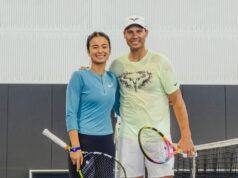Belinda Bencic isn’t one to exert pressure on herself. She has learned not to, having seen the pitfalls of great expectations both as an accomplished junior and as a well-traveled pro. She is, if nothing else, pragmatic, and especially in her assessment of self. For example, she concedes that she has “less talent and touch” than compatriot and mentor Martina Hingis, five-time major titleholder and daughter to former coach Melanie Molitor. No doubt, her nuanced view of her potential stems from her roller-coaster experience. She had ups early on, including a quarterfinal-round appearance in the 2014 United States Open and two Women’s Tennis Association Tour titles the next year. Then she had downs, among them wrist surgery in 2017 and its protracted period of convalescence.
Creditably, Bencic has managed to retain her love of the game throughout; she sees the adversities she has faced as necessary for growth. “I think all true athletes have to overcome obstacles, injuries, just tough times. I think it made me a stronger person, better player.” Indeed. Which is why she seems to thrive in the grandest stages, and against players with far stellar resumes. Just yesterday, she halted the US Open run of defending singles champion Naomi Osaka with a decisive 7-5, 6-4 fourth-round thrashing that had her dictating points from the get-go. Not coincidentally, it was her fourth straight victory, and third this year, over the World Number One.
Ask Bencic, and she’d say her biggest asset is her ability to counter her opponent’s strengths or, at the very least, render them ineffective. Yesterday, she managed to rein in Osaka’s power with well-timed and -placed shots. That she had thrice as many double faults as aces — exactly the multiplier her opponent boasted of, but in the opposite application — underscored her capacity to construct points until opportunities to strike presented themselves. She was so patient and precise — if decisive, relentless in her intent to crowd the baseline and take the ball early — that the game looked easy for her.
In truth, much of Bencic’s success on the court stems from her steadfast preparation long before the actual matches. If she’s aware of what she needs to do, it’s because she has scouted the competition herself. She certainly paid attention to Osaka’s masterful performance against Coco Gauff in the previous round, personal taking it in from the stands at Arthur Ashe Stadium. Needless to say, she figures to do the same in the run-up to her meeting with Donna Vekic, another oft-injured player also on the comeback trail. “It’s great that one of us will be in the semifinals,” she said, not needing to note that she’s already laying the groundwork to claim the privilege.
Anthony L. Cuaycong has been writing Courtside since BusinessWorld introduced a Sports section in 1994. He is a consultant on strategic planning, operations and Human Resources management, corporate communications, and business development.



